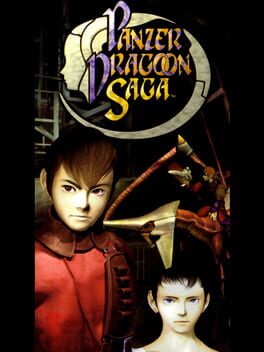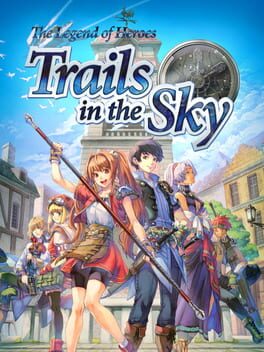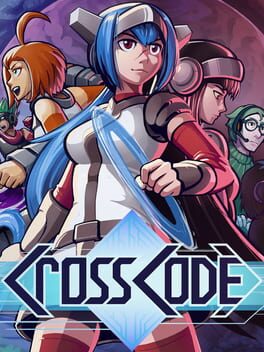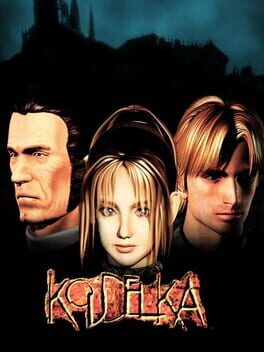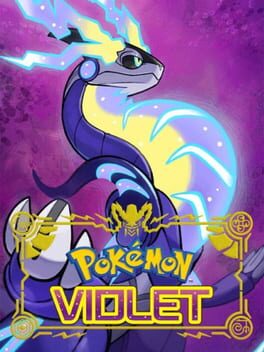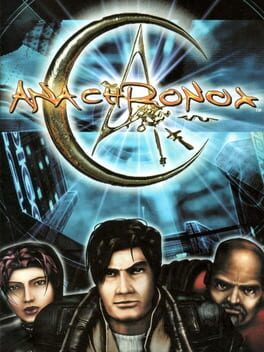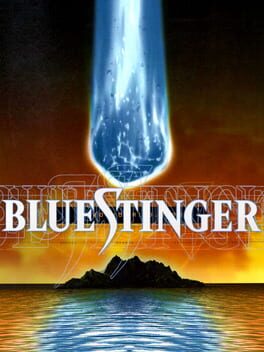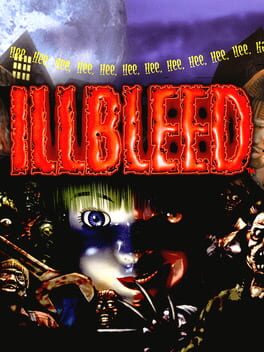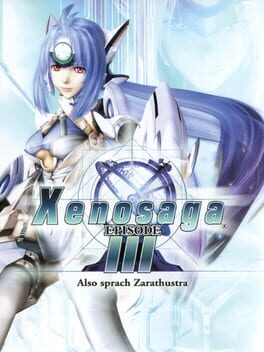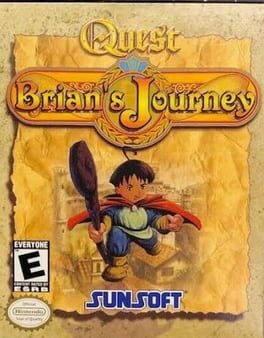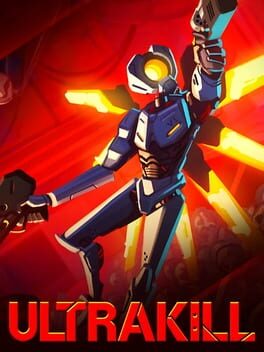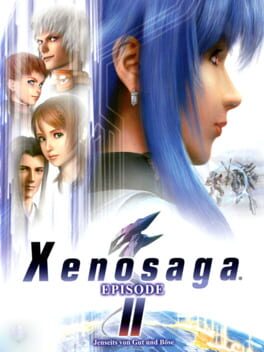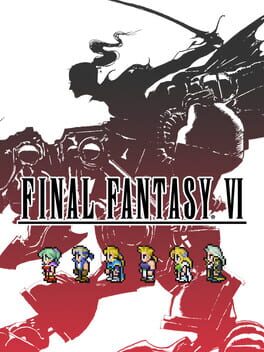ReeseWB
1998
This swan song of the Saturn is well regarded for good reason - despite its short length (my nearly 100% run clocked in at fourteen and a half hours) and relative lack of difficulty, Panzer Dragoon Saga is filled with unique gameplay, memorable characters, the unique and mysterious setting this series is known for, and an unforgettable conclusion to the trilogy of games on the Saturn. Desperately needs the remake treatment to bring fresh eyes onto it, as this is a journey few who've played it could ever forget.
2018
1999
2022
2001
Anachronox is a labor of love that suffers in the gameplay department.
The game's writing, characterization, and storytelling are all top notch, and the cutscenes that go with that story are all directed fantastically (to the point where the game was edited into a film at one point).
The game's environments, while occasionally not the best graphically (specifically areas like the canyons of Democratus), are still very unique and well designed, and this is supported by great sound design and a phenomenal soundtrack (highlights for me being the theme of Hephaestus and Stiletto's theme).
The one place the game suffers, unfortunately, is in its actual gameplay. Combat is slow and not very strategic (though the idea of moving around the battlefield and interacting with the environment is a great one), only two or three dungeons are more interesting than a leisurely walk, and the puzzles can occasionally become tedious and annoying.
However, I don't think Anachronox's gameplay failings override the rest of the game, which is absolutely fantastic. If nothing else? Absolutely worth watching the movie edit. Otherwise, highly recommended for those who enjoy rich worldbuilding and witty writing alongside a great story.
Oh, and one final thing, this game easily has the most unique party in any RPG. Without question.
The game's writing, characterization, and storytelling are all top notch, and the cutscenes that go with that story are all directed fantastically (to the point where the game was edited into a film at one point).
The game's environments, while occasionally not the best graphically (specifically areas like the canyons of Democratus), are still very unique and well designed, and this is supported by great sound design and a phenomenal soundtrack (highlights for me being the theme of Hephaestus and Stiletto's theme).
The one place the game suffers, unfortunately, is in its actual gameplay. Combat is slow and not very strategic (though the idea of moving around the battlefield and interacting with the environment is a great one), only two or three dungeons are more interesting than a leisurely walk, and the puzzles can occasionally become tedious and annoying.
However, I don't think Anachronox's gameplay failings override the rest of the game, which is absolutely fantastic. If nothing else? Absolutely worth watching the movie edit. Otherwise, highly recommended for those who enjoy rich worldbuilding and witty writing alongside a great story.
Oh, and one final thing, this game easily has the most unique party in any RPG. Without question.
1999
Much like this company's other game, Illbleed, Blue Stinger has a great world and atmosphere that's marred by poor gameplay. Unlike Illbleed, however, Blue Stinger's world can't make up for the gameplay shortcomings, and completing this game can be a miserable experience. There's enough here for me to enjoy, but not enough to merit playing through the entire game rather than watching a playthrough online.
2001
This game singlehandedly shaped my entire taste in media and I feel both happy and terrible about that.
Simultaneously a mess of mechanics and poor level design and a wellspring of clever parody and satire of classic movie tropes that can't be described by human language. I don't know why this game keeps gravitating me back to it, even with its many flaws, but there's an earnest passion and creativity in Illbleed that isn't matched in many games.
A must-play for fans of horror films, the Dreamcast, and corny B-movie goodness alike.
Simultaneously a mess of mechanics and poor level design and a wellspring of clever parody and satire of classic movie tropes that can't be described by human language. I don't know why this game keeps gravitating me back to it, even with its many flaws, but there's an earnest passion and creativity in Illbleed that isn't matched in many games.
A must-play for fans of horror films, the Dreamcast, and corny B-movie goodness alike.
2022
This is easily the best Xenosaga game.
That's a strong way to open a review, but coming directly off of Episode II this was a massive breath of fresh air. So many improvements have been made between not only this game and Episode II but even things from Episode I that, while I said in a previous review that one might be better off watching Xenosaga rather than playing it, Episode III is the exception.
I'll begin with the usual non-spoilery story section. Despite an entire part of Xenosaga's story essentially being cut due to the series' overall poor sales, the year span in-universe between Episode II and Episode III is easily accesible via the game's great new Glossary system, returning even better from Episode I. Being able to access story events and terms while cross-referencing other relevant terms is great, and the database updates as the story goes on to help quell a lot of the confusion Xenosaga's narrative is famous for. The story of Episode III is easily the best constructed of the three games, with a lot of beautifully animated cutscenes and even fully voiced text boxes that conclude the story of this trilogy rather satisfyingly (while also leaving room for a sequel should the day ever come). This is supplemented by a lot of returning voice actors from Episode I and even some new ones (Steve Blum and Yuri Lowenthal can be heard within the first hour, for example), and the voice direction is miles ahead of Episode II, leading to this being my favorite game to watch the story of.
But the story isn't the only thing that has been improved in Episode III. Finally, FINALLY, the combat has been fine tuned to be fast and fun to play both on foot and in the E.S. Gone is any semblance of the combo system, instead just having regular attacks and Techs as separate menu options. The Break system has been balanced as to not completely crowd battles, and the Boost mechanic also FINALLY lets you boost while a character is on the turn order, something that bugged the hell out of me in Episode II. The Boost meter has also been given another purpose - every character has special attacks that take Boost to perform. These specials have elaborate animations like the Techs of Episode I, but don't take an eternity to play out and don't happen every turn, making battles feel unique while still being fast. There wasn't a point in this game where I felt bored fighting a regular enemy.
The E.S. have also been generally improved over Episode II. For one, the dungeons where you ride them are much more elaborate than the straight lines from Episode II, with actual puzzles and interesting areas. The combat is also a lot of fun, with the Anima system adding layers of strategy more than the mechanic in II that...I honestly don't remember the name of, but was used for a whole two attacks on each E.S. that weren't much better than your regular attacks. The co-op, ambush, revenge, and counter systems are also fun to play around, and outfitting your E.S. with specific weapons that use specific amounts of fuel reminds me a lot of how Skells would end up working in Xenoblade X (though obviously in a turn based system instead of the Xenoblade real time combat). The E.S. fights were also a lot more challenging, with certain ones near the endgame being among my favorites in the entire Xeno franchise now.
The game isn't without its issues. For one thing, like Episode II, while you can switch out party members at any time in battle, you can't switch anyone out if they're dead, meaning you need to revive them with either the high EP revival skills, the common Revive M item, or the Seven Moons item that decides to stop appearing in stores partway through the game. This can be annoying during the game's harder boss fights, especially some of the E.S. bosses near the endgame. Another issue is with Shion's characterization. For the first time, the person billed as the main character actually feels like the main character of the story (in the previous two games, while Shion begins the story, Jr. is clearly the focal character due to his strong connection to the main villain). This is a good thing by itself, but Shion's characterization has taken an...odd turn. While in the first game she was headstrong (if a workaholic) and was...there in the second game, in Episode III she acts much more hostile towards everyone in the party for...no discernable reason? I understand that the events between Episodes II and III caused her to undergo some change, but the amount of annoyance she expresses towards a good portion of the cast makes her uncomfortable to be around at times. There's also a certain story event that many have commented on that make her a divisive protagonist, but I don't want to get into that here for want of no spoilers. All I'll say is that I understand what was trying to be conveyed in that scene and like what they were trying to do, the execution is a bit lacking.
I'll end this review on a higher note: the MUSIC. While Episode I lacked music in most of its areas and Episode II's OST was a very mixed bag, Episode III's soundtrack is nothing but hits for me. As early as the first dungeon you get the jazzy "Rolling Down the U.M.N.," and the hits keep coming after that. Personal highlights for me are the aformentioned song, both versions of T-elos' theme, and the rendition of Episode II's "fatal fight." The soundtrack is simply incredible, and worth a listen on its own merits.
Overall, Xenosaga Episode III: Also sprach Zarathustra has been a welcome surprise for me after binging this trilogy (and Xenogears). While it doesn't reach the heights of Gears, or even some of the Blade games, it's a solid RPG that I would highly reccomend playing. A solid conclusion to a troubled trilogy.
That's a strong way to open a review, but coming directly off of Episode II this was a massive breath of fresh air. So many improvements have been made between not only this game and Episode II but even things from Episode I that, while I said in a previous review that one might be better off watching Xenosaga rather than playing it, Episode III is the exception.
I'll begin with the usual non-spoilery story section. Despite an entire part of Xenosaga's story essentially being cut due to the series' overall poor sales, the year span in-universe between Episode II and Episode III is easily accesible via the game's great new Glossary system, returning even better from Episode I. Being able to access story events and terms while cross-referencing other relevant terms is great, and the database updates as the story goes on to help quell a lot of the confusion Xenosaga's narrative is famous for. The story of Episode III is easily the best constructed of the three games, with a lot of beautifully animated cutscenes and even fully voiced text boxes that conclude the story of this trilogy rather satisfyingly (while also leaving room for a sequel should the day ever come). This is supplemented by a lot of returning voice actors from Episode I and even some new ones (Steve Blum and Yuri Lowenthal can be heard within the first hour, for example), and the voice direction is miles ahead of Episode II, leading to this being my favorite game to watch the story of.
But the story isn't the only thing that has been improved in Episode III. Finally, FINALLY, the combat has been fine tuned to be fast and fun to play both on foot and in the E.S. Gone is any semblance of the combo system, instead just having regular attacks and Techs as separate menu options. The Break system has been balanced as to not completely crowd battles, and the Boost mechanic also FINALLY lets you boost while a character is on the turn order, something that bugged the hell out of me in Episode II. The Boost meter has also been given another purpose - every character has special attacks that take Boost to perform. These specials have elaborate animations like the Techs of Episode I, but don't take an eternity to play out and don't happen every turn, making battles feel unique while still being fast. There wasn't a point in this game where I felt bored fighting a regular enemy.
The E.S. have also been generally improved over Episode II. For one, the dungeons where you ride them are much more elaborate than the straight lines from Episode II, with actual puzzles and interesting areas. The combat is also a lot of fun, with the Anima system adding layers of strategy more than the mechanic in II that...I honestly don't remember the name of, but was used for a whole two attacks on each E.S. that weren't much better than your regular attacks. The co-op, ambush, revenge, and counter systems are also fun to play around, and outfitting your E.S. with specific weapons that use specific amounts of fuel reminds me a lot of how Skells would end up working in Xenoblade X (though obviously in a turn based system instead of the Xenoblade real time combat). The E.S. fights were also a lot more challenging, with certain ones near the endgame being among my favorites in the entire Xeno franchise now.
The game isn't without its issues. For one thing, like Episode II, while you can switch out party members at any time in battle, you can't switch anyone out if they're dead, meaning you need to revive them with either the high EP revival skills, the common Revive M item, or the Seven Moons item that decides to stop appearing in stores partway through the game. This can be annoying during the game's harder boss fights, especially some of the E.S. bosses near the endgame. Another issue is with Shion's characterization. For the first time, the person billed as the main character actually feels like the main character of the story (in the previous two games, while Shion begins the story, Jr. is clearly the focal character due to his strong connection to the main villain). This is a good thing by itself, but Shion's characterization has taken an...odd turn. While in the first game she was headstrong (if a workaholic) and was...there in the second game, in Episode III she acts much more hostile towards everyone in the party for...no discernable reason? I understand that the events between Episodes II and III caused her to undergo some change, but the amount of annoyance she expresses towards a good portion of the cast makes her uncomfortable to be around at times. There's also a certain story event that many have commented on that make her a divisive protagonist, but I don't want to get into that here for want of no spoilers. All I'll say is that I understand what was trying to be conveyed in that scene and like what they were trying to do, the execution is a bit lacking.
I'll end this review on a higher note: the MUSIC. While Episode I lacked music in most of its areas and Episode II's OST was a very mixed bag, Episode III's soundtrack is nothing but hits for me. As early as the first dungeon you get the jazzy "Rolling Down the U.M.N.," and the hits keep coming after that. Personal highlights for me are the aformentioned song, both versions of T-elos' theme, and the rendition of Episode II's "fatal fight." The soundtrack is simply incredible, and worth a listen on its own merits.
Overall, Xenosaga Episode III: Also sprach Zarathustra has been a welcome surprise for me after binging this trilogy (and Xenogears). While it doesn't reach the heights of Gears, or even some of the Blade games, it's a solid RPG that I would highly reccomend playing. A solid conclusion to a troubled trilogy.
Playing this after Quest 64 is an interesting experience.
I'll start by saying that all issues and advantages with the N64 version are still present in this version, with two exceptions that I'll get into. The combat is still an interesting idea, but not executed the best, the story's still rather barebones, etc. I've said my peace on that game before. The games run for roughly the same length, though this one might take a shorter time still (and the leveling system is sped up to compensate as far as I can tell).
The first major difference, though the less notable of the two, is the dungeons. Quest 64 already didn't have the best dungeons (none of them had any puzzles or gimmicks, just being sightseeing tours with random encounters), but here the game's format makes them worse by virtue of not even having the quaint N64 visuals to minorly distract the player. It makes an already rather tedious game even less interesting.
The bigger difference, however, is the story. Quest 64 rather infamously is devoid of story for the most part (apparently due to development constraints), with its only actual cutscene being exclusive to the Japanese version's ending. Quest: Brian's Journey, however, makes use of cutscenes much more frequently, and as a result actually fleshes out the world of Celtland and the characters from the original game. There are new bosses as well, and even an entire new story section near the end between what used to be the penultimate and final dungeon. Said section even incorporates the original games (apparent) cut party members as travel companions and cutscene participants, as they'd been reduced to NPC status in the N64 version. It's rather interesting to see some of the things they'd planned for Quest 64 here, even if the story still isn't anything particularly special.
Overall, Quest: Brian's Journey is an alright distraction of a Game Boy RPG, and if nothing else is a nice companion piece to the N64 version. However, if the N64 version didn't interest you, this won't change your mind, new story content or not.
(Also, I think I'm the first person to make a proper review of this game on this website. Don't know if that's an honor or not.)
I'll start by saying that all issues and advantages with the N64 version are still present in this version, with two exceptions that I'll get into. The combat is still an interesting idea, but not executed the best, the story's still rather barebones, etc. I've said my peace on that game before. The games run for roughly the same length, though this one might take a shorter time still (and the leveling system is sped up to compensate as far as I can tell).
The first major difference, though the less notable of the two, is the dungeons. Quest 64 already didn't have the best dungeons (none of them had any puzzles or gimmicks, just being sightseeing tours with random encounters), but here the game's format makes them worse by virtue of not even having the quaint N64 visuals to minorly distract the player. It makes an already rather tedious game even less interesting.
The bigger difference, however, is the story. Quest 64 rather infamously is devoid of story for the most part (apparently due to development constraints), with its only actual cutscene being exclusive to the Japanese version's ending. Quest: Brian's Journey, however, makes use of cutscenes much more frequently, and as a result actually fleshes out the world of Celtland and the characters from the original game. There are new bosses as well, and even an entire new story section near the end between what used to be the penultimate and final dungeon. Said section even incorporates the original games (apparent) cut party members as travel companions and cutscene participants, as they'd been reduced to NPC status in the N64 version. It's rather interesting to see some of the things they'd planned for Quest 64 here, even if the story still isn't anything particularly special.
Overall, Quest: Brian's Journey is an alright distraction of a Game Boy RPG, and if nothing else is a nice companion piece to the N64 version. However, if the N64 version didn't interest you, this won't change your mind, new story content or not.
(Also, I think I'm the first person to make a proper review of this game on this website. Don't know if that's an honor or not.)
2020
My hands are in pain but the adrenaline rush is more than worth it. Incredibly fluid movement, fun gunplay (partially due to the movement), plenty of fun exploration and secrets, and incentive to perfect each stage leads this to be one of the most addicting games I've ever played. It requires you to learn its mechanics in each stage and will regularly test you with its boss fights and in-level challenges. Multiple difficulties also add to this game's massive replay value. Cannot recommend enough.
This was a very bizarre experience for me.
I'll preface this review by saying that I played Xenosaga Episode I hot off the heels of my playthrough of Xenogears (which, as of writing this review, I am still gathering my full thoughts on), so that may have colored my experience somewhat. Comparisons will be made in a dedicated section of this review, though I will be sure to judge the game on its own merits first before I make a comparison to its spiritual predecessor.
I'll begin with a brief section here on the story, which will consist of about a third of your playthrough. Xenosaga makes extensive use of lengthy cutscenes to tell its story - according to a compilation on YouTube, about ten hours worth of them. Considering my playthrough was just under 30 hours, this means that a lot of your time playing Xenosaga will, in fact, be spent watching Xenosaga. This isn't to say that other RPGs don't make use of long cutscenes, but Xenosaga in particular usually strings cutscenes together for so long that you'll feel like you're watching a movie more than playing a game. This isn't necessarily entirely a bad thing - for what it's worth, the cutscenes are very well made, and the story told through them is one that keeps player interest all the way through to the end, but the sheer amount and length of them can easily turn off a prospective player.
Now moving onto gameplay, I'll start with the out of battle sections. While there aren't a lot of towns to explore in Xenosaga, the ones that are here all feel very well thought out and lived in. There's a lot to do in each hub area, and plenty to explore if you're doing the game's sidequests. My issue with this comes from the game's dungeons - most of them are rather bland to look at, don't contain much to make them unique, and crucially don't have backing music to give them more personality. Not all of the game's dungeons fit these criteria, but most of them do, and it overall makes them bland to travel through. Not helped by this is how slow your character moves, which makes them even more of a slog. Additionally, close to the end of the game, the game's difficulty gets wildly inconsistent, spiking during one dungeon and going back to normal in the next. This last point's not entirely an issue, but it bothers me that the enemy radar on the HUD isn't also a minimap. This was also an issue I had in Xenogears, but I'm getting ahead of myself.
Moving onto the combat, I don't have much more positive to say, unfortunately. Combat is turn based in a similar way to Final Fantasy X, with turn order shown on the right side of the screen. Next to the turn order is the battle roulette, which changes per every combatant's turn - these two aspects are things I actually enjoy, since they add a lor of variance to fights - by attacking or using certain items/skills, you can gain "boost" for a character. If a character is not in the turn order but has boost, you can press R2 and the character's corresponding button to move them instantly to the front of the turn order. This system is actually very fun to play with. Attacking is done with the Square, Triangle, and Circle buttons - Square for physical attacks, Triangle (typically) for Ether attacks, and Circle for either KOS-MOS' equipped weapon or to activate a Tech attack. This, however, is where my praise ends. Tech Attacks are executed by first learning them via level up then setting them to a button combination in the menu (similar to Xenogears Deathblow system, but you can upgrade older Techs to keep them relevant). You then enter the button combo in battle (which may require guarding for a turn to get enough "AP" to use it), and your character does their special move. Seems fine by description, and they do a lot of damage, but the issue lies in how long each attack takes to use - every Tech has an incredibly long animation, making fights take much longer than they should. This isn't an issue in the early game, since enemies don't have a lot of health anyways and you need to build up to Techs, but as you get later and later into the game and you upgrade the Speed on your Techs to be able to use them every turn, battles begin to slow to a crawl. By the end of the game, I began to wonder if I was better off just watching the cutscenes online than actually playing the game. Finally, to bring up the music again, the game has exactly two battle themes - the regular battle theme, used in every fight except the final boss, and the final boss theme. The regular battle theme isn't a bad song, but after hearing it so often with no variation it begins to harken back to my memories of Sonic Unleashed's battle theme.
And now we reach the segment where I compare Xenosaga to its spiritual predecessor, Xenogears (which I've already done a couple times, but...uh...shut up). In playing Xenosaga, I noticed that for as many interesting improvements this game makes over Gears, it also regresses in a number of ways. It improves the basic combat with the boost system and Tech attacks being upgradeable, but also removes a lot of the interest of learning new skills by experimenting with button combinations. Every character in the story gets their moment to shine and stays relevant all the way through, but the story doesn't fully resolve all of its points, and not in a way that's just waiting for the sequel (this was due to development constraints). There's on-field encounters and an enemy radar, but they still didn't implement any kind of map system to help get one's bearings. For every good thing Xenosaga changes, it also does something else arguably worse.
Overall, while I didn't have as fantastic a time with Xenosaga Episode I as I did with its predecessor, it's still a fine enough RPG. It's very rough, and long play sessions will require a lot of patience, but it's a decent start to this trilogy. Not a game I'll be returning to play any time in the future most likely, but certainly one I'd rewatch the cutscenes for anytime.
I'll preface this review by saying that I played Xenosaga Episode I hot off the heels of my playthrough of Xenogears (which, as of writing this review, I am still gathering my full thoughts on), so that may have colored my experience somewhat. Comparisons will be made in a dedicated section of this review, though I will be sure to judge the game on its own merits first before I make a comparison to its spiritual predecessor.
I'll begin with a brief section here on the story, which will consist of about a third of your playthrough. Xenosaga makes extensive use of lengthy cutscenes to tell its story - according to a compilation on YouTube, about ten hours worth of them. Considering my playthrough was just under 30 hours, this means that a lot of your time playing Xenosaga will, in fact, be spent watching Xenosaga. This isn't to say that other RPGs don't make use of long cutscenes, but Xenosaga in particular usually strings cutscenes together for so long that you'll feel like you're watching a movie more than playing a game. This isn't necessarily entirely a bad thing - for what it's worth, the cutscenes are very well made, and the story told through them is one that keeps player interest all the way through to the end, but the sheer amount and length of them can easily turn off a prospective player.
Now moving onto gameplay, I'll start with the out of battle sections. While there aren't a lot of towns to explore in Xenosaga, the ones that are here all feel very well thought out and lived in. There's a lot to do in each hub area, and plenty to explore if you're doing the game's sidequests. My issue with this comes from the game's dungeons - most of them are rather bland to look at, don't contain much to make them unique, and crucially don't have backing music to give them more personality. Not all of the game's dungeons fit these criteria, but most of them do, and it overall makes them bland to travel through. Not helped by this is how slow your character moves, which makes them even more of a slog. Additionally, close to the end of the game, the game's difficulty gets wildly inconsistent, spiking during one dungeon and going back to normal in the next. This last point's not entirely an issue, but it bothers me that the enemy radar on the HUD isn't also a minimap. This was also an issue I had in Xenogears, but I'm getting ahead of myself.
Moving onto the combat, I don't have much more positive to say, unfortunately. Combat is turn based in a similar way to Final Fantasy X, with turn order shown on the right side of the screen. Next to the turn order is the battle roulette, which changes per every combatant's turn - these two aspects are things I actually enjoy, since they add a lor of variance to fights - by attacking or using certain items/skills, you can gain "boost" for a character. If a character is not in the turn order but has boost, you can press R2 and the character's corresponding button to move them instantly to the front of the turn order. This system is actually very fun to play with. Attacking is done with the Square, Triangle, and Circle buttons - Square for physical attacks, Triangle (typically) for Ether attacks, and Circle for either KOS-MOS' equipped weapon or to activate a Tech attack. This, however, is where my praise ends. Tech Attacks are executed by first learning them via level up then setting them to a button combination in the menu (similar to Xenogears Deathblow system, but you can upgrade older Techs to keep them relevant). You then enter the button combo in battle (which may require guarding for a turn to get enough "AP" to use it), and your character does their special move. Seems fine by description, and they do a lot of damage, but the issue lies in how long each attack takes to use - every Tech has an incredibly long animation, making fights take much longer than they should. This isn't an issue in the early game, since enemies don't have a lot of health anyways and you need to build up to Techs, but as you get later and later into the game and you upgrade the Speed on your Techs to be able to use them every turn, battles begin to slow to a crawl. By the end of the game, I began to wonder if I was better off just watching the cutscenes online than actually playing the game. Finally, to bring up the music again, the game has exactly two battle themes - the regular battle theme, used in every fight except the final boss, and the final boss theme. The regular battle theme isn't a bad song, but after hearing it so often with no variation it begins to harken back to my memories of Sonic Unleashed's battle theme.
And now we reach the segment where I compare Xenosaga to its spiritual predecessor, Xenogears (which I've already done a couple times, but...uh...shut up). In playing Xenosaga, I noticed that for as many interesting improvements this game makes over Gears, it also regresses in a number of ways. It improves the basic combat with the boost system and Tech attacks being upgradeable, but also removes a lot of the interest of learning new skills by experimenting with button combinations. Every character in the story gets their moment to shine and stays relevant all the way through, but the story doesn't fully resolve all of its points, and not in a way that's just waiting for the sequel (this was due to development constraints). There's on-field encounters and an enemy radar, but they still didn't implement any kind of map system to help get one's bearings. For every good thing Xenosaga changes, it also does something else arguably worse.
Overall, while I didn't have as fantastic a time with Xenosaga Episode I as I did with its predecessor, it's still a fine enough RPG. It's very rough, and long play sessions will require a lot of patience, but it's a decent start to this trilogy. Not a game I'll be returning to play any time in the future most likely, but certainly one I'd rewatch the cutscenes for anytime.
I've yet to get all my thoughts on this game's predecessor down at time of writing, but I can safely say that this is a step down. In a way, it continues a trend I observed in Episode I (when comparing it to its spiritual predecessor, Xenogears). There are many things from the previous game that Episode II improves on, but there are just as many that it falls short on.
Before I get into that, a quick note on the story. While the game is much shorter than the first (about ten hours by my playtime), the story is a great direct continuation. While this is (apparently) due to the game using all of the story content cut from the first game, it still is a natural continuation of the character arcs and story from the previous game. I very much recommend watching a cutscene compilation of the Xenosaga games if the gameplay doesn't interest you, because it is still rather good.
For the things I will legitimately credit Episode II, the battle system is much faster, no longer having incredibly long Ether casting or Tech Attack animations that clog up even random fodder fights. The new "stock" system, shared boost meter, "break" mechanics, and small changes to the turn roulette also lead to a good amount of strategy in the game's boss fights. The game also has much more music than the first one, which had a lot of silence and music reuse (such as only having two battle themes, one of which was reserved only for the final boss). Episode II also looks significantly better graphically in its areas (though the character design changes take time to get used to if coming directly off of Episode I), and many dungeons have more to do in them than Episode I's and don't spike in difficulty at any point. I also appreciate the better UI for the skill tree system, something I'd struggled with in the first game.
Despite these improvements, however, I feel that Xenosaga Episode II is the weakest entry in the "Xeno" series by far. Not the newest opinion, I'm aware, but one I find myself agreeing with. Despite the combat being faster than Episode I, it ends up being just as tedious to fight anything that isn't a boss. However, while Episode I's combat was slow due to long animations for your high-damage moves, Episode II gives most enemies an absurd amount of health that causes fights to drag on. Combat in mechs (now renamed to E.S. instead of A.W.G.S. (though sometimes referred to in-game as A.M.W.S.?)) feels more impactful than the first game due to not just being an optional...option in the battle menu, though actually traveling in an E.S. is rather slow, and all areas where you pilot one are incredibly linear. And arguably my biggest issue is the removal of a shop system - items can only be gained from enemies, objects/chests, and sidequests, meaning in order to stock up on even basic healing items you'll need to grind enemies. This is a very frustrating change, especially when it comes to status healing items in the late game.
Another thing is the game's length. The game comes on two discs, though you'll be switching to disc 2 after only about 8 hours, with the remaining ~12 hours on that disc. Xenosaga is known for having long sequences of cutscenes, but the actual gameplay time of Episode II will primarily be filled out by the game's many sidequests (G.S. Quests in-universe). By my rough estimate, if I hadn't bothered with many of these sidequests, my playtime would be a good two to three hours shorter. There's not a lot to many of these quests either, making them feel more like busywork that gives okay to pitiful rewards. They feel like filler to pad out game time rather than fun side activities that flesh out the world.
A final point I want to make is about the voice direction. While a large portion of the voice cast of the first game didn't return for this one, they were replaced with talented actors all the same; even then, some remained, such as Richard Epcar as Ziggy and Brianne Sidhall as Jr.. I mention this because I feel this clearly shows how poor the voice direction is - the returning actors sound just as stiff as the new ones, meaning that the direction is to blame. It's not horrible for the most part, but it can be distracting on a number of occasions.
Overall, while I wasn't the biggest fan of the first game, Xenosaga Episode II is still a disappointment to me. I can see kernels of a genuinely improved sequel scattered around between all of the frustrating things. I'm optimistic about Episode III, due to both the general ratings on this very website and word of mouth that it's the best of the trilogy, but I'll have to see when I get there.
Before I get into that, a quick note on the story. While the game is much shorter than the first (about ten hours by my playtime), the story is a great direct continuation. While this is (apparently) due to the game using all of the story content cut from the first game, it still is a natural continuation of the character arcs and story from the previous game. I very much recommend watching a cutscene compilation of the Xenosaga games if the gameplay doesn't interest you, because it is still rather good.
For the things I will legitimately credit Episode II, the battle system is much faster, no longer having incredibly long Ether casting or Tech Attack animations that clog up even random fodder fights. The new "stock" system, shared boost meter, "break" mechanics, and small changes to the turn roulette also lead to a good amount of strategy in the game's boss fights. The game also has much more music than the first one, which had a lot of silence and music reuse (such as only having two battle themes, one of which was reserved only for the final boss). Episode II also looks significantly better graphically in its areas (though the character design changes take time to get used to if coming directly off of Episode I), and many dungeons have more to do in them than Episode I's and don't spike in difficulty at any point. I also appreciate the better UI for the skill tree system, something I'd struggled with in the first game.
Despite these improvements, however, I feel that Xenosaga Episode II is the weakest entry in the "Xeno" series by far. Not the newest opinion, I'm aware, but one I find myself agreeing with. Despite the combat being faster than Episode I, it ends up being just as tedious to fight anything that isn't a boss. However, while Episode I's combat was slow due to long animations for your high-damage moves, Episode II gives most enemies an absurd amount of health that causes fights to drag on. Combat in mechs (now renamed to E.S. instead of A.W.G.S. (though sometimes referred to in-game as A.M.W.S.?)) feels more impactful than the first game due to not just being an optional...option in the battle menu, though actually traveling in an E.S. is rather slow, and all areas where you pilot one are incredibly linear. And arguably my biggest issue is the removal of a shop system - items can only be gained from enemies, objects/chests, and sidequests, meaning in order to stock up on even basic healing items you'll need to grind enemies. This is a very frustrating change, especially when it comes to status healing items in the late game.
Another thing is the game's length. The game comes on two discs, though you'll be switching to disc 2 after only about 8 hours, with the remaining ~12 hours on that disc. Xenosaga is known for having long sequences of cutscenes, but the actual gameplay time of Episode II will primarily be filled out by the game's many sidequests (G.S. Quests in-universe). By my rough estimate, if I hadn't bothered with many of these sidequests, my playtime would be a good two to three hours shorter. There's not a lot to many of these quests either, making them feel more like busywork that gives okay to pitiful rewards. They feel like filler to pad out game time rather than fun side activities that flesh out the world.
A final point I want to make is about the voice direction. While a large portion of the voice cast of the first game didn't return for this one, they were replaced with talented actors all the same; even then, some remained, such as Richard Epcar as Ziggy and Brianne Sidhall as Jr.. I mention this because I feel this clearly shows how poor the voice direction is - the returning actors sound just as stiff as the new ones, meaning that the direction is to blame. It's not horrible for the most part, but it can be distracting on a number of occasions.
Overall, while I wasn't the biggest fan of the first game, Xenosaga Episode II is still a disappointment to me. I can see kernels of a genuinely improved sequel scattered around between all of the frustrating things. I'm optimistic about Episode III, due to both the general ratings on this very website and word of mouth that it's the best of the trilogy, but I'll have to see when I get there.
2022
There are few games that I've played recently that have such a legacy as Final Fantasy VI. I've been playing most of the classic Final Fantasy titles for the first time with these Pixel Remasters (barring IV, the first one I played, and V, which I'd played most of via the old SNES fan translation a number of years ago), and this was easily the one I was the most curious about.
...Well, maybe aside from II due to its unique leveling system, but nonetheless. VI is very much one of the most well-known games in the series, so going into it I tried to temper my expectations; going in with the idea that this was a classic RPG and one of the best on the SNES could set my expectations too high, after all.
I'll begin with the story, though due to the nature of this game's particular structure I won't go too in depth. Many, many years ago, there was a massive war known as the War of the Magi, after which magic almost completely vanished from the world. In the present day, an Empire led by a man named Gestahl has created "Magitek," an artificial way to imbue people with magic, and is planning to conquer the planet with his massive army, led by the insane clown Kefka. Terra, a girl under the control of the Empire and forced into a suit of Magitek armor, is taken on a mission to the rebelling town of Narshe, where she and two other soldiers find a frozen creature called an Esper, which quickly dispatches the two soldiers and frees Terra from her mind control. Terra then escapes from Narshe, meeting the treasure hunter Locke, a member of the Returners - the main group opposing the Empire. From there, the story unfolds with many different focus characters, with twists, turns, and the occasional opera in-between.
VI goes for a different approach to its plot structure than the rest of the series (at least, as far as I'm aware - I haven't played XII or XV) by having more of an ensemble cast instead of a strict main character. You begin the game as Terra, the Magitek pilot who has lost her memory and emotion thanks to manipulation from the Empire, but not too long after you finally accrue a four-man party the game gives you the choice of three scenarios, each with a different focus character. No part of the game really focuses enough on one character to make them feel like the central protagonist, which I think is very interesting.
That isn't to say that there aren't characters the game focuses on more than others. Terra, as stated before, begins as the "protagonist," and is given a majority of the focus in the game's first half. Locke, master treasure hunter, Edgar and Sabin, kings of Figaro Castle, and Celes, former general of the Empire, are also given a lot of time in the sun in that first half. This leads to them being the more memorable party members in terms of actual character, but due to the game's large roster of party members, many fall by the wayside. Cyan, last warrior of Doma, Relm and Strago, two of the last remaining Magi, Shadow the ninja/assassin, Gau, the boy living in the wild of the Veldt, Mog the...Moogle who dances, and Setzer the airship pilot all get small moments in the spotlight, but don't do much after said moments in terms of plot significance. While the game's overall story is still rather solid in this first half, the use of its large roster seems a bit lacking.
The game's second half is where things get more interesting. Without going into plot details, the world map essentially opens up in the second half, with the game allowing you to either do character-specific sidequests to give some resolution to their arcs or go straight to the final dungeon. While this change does stall the rather well paced story from the first half, this openness is something no other FF game had done before it, and it makes FFVI stand out for that reason.
While I enjoy the structural switch up, there is still an issue I have with the game's second half. The individual character sidequests are great, but there's a problem with all of them but one - the nature of the second half of the game means that you can theoretically have ANY party when you do these sidequests, which means that the dialogue during these scenes is rather...generic aside from the focus character. Celes has no particular reaction to finding Locke alive, Edgar and Sabin don't have any particular words to say to one another when they reunite, etc. There is one - ONE - point where characters will actually all contribute to a sidequest: Gau's sidequest. Depending on how much of your party that you have during this point in the game, you'll get scenes involving the whole party that are genuinely funny and heartwarming for one of the game's least important characters. It's something that would've been nice to see for some other characters as well.
When it comes to the gameplay of FFVI, there's only a few major differences from the previous two games. Gone is V's robust job system, as the characters in this game are relegated to one job much like IV. Locke can steal things, Edgar can use tools, Relm can sketch enemies to copy their attacks, Gogo can mimic, etc. However, every character has access to magicite, crystals containing the souls of Espers that will allow them to learn magic and gain stat buffs depending on the magicite equipped. This mechanic is a precursor to VII's much more well known Materia system, and...I'm not the biggest fan of it here. I find that thanks to the magicite system, many characters become...mostly useless? At least, when it comes to their specific skills. Take Gau, for example. He's a variant of a Blue Mage, able to leap onto enemies in his homeland, the Veldt, and learn their entire movesets (known as Rages). When you use rages in battle, Gau becomes uncontrollable, but will use those enemy skills. A very interesting idea, but one that I believe is undercut by being able to just teach him powerful spells and then keep him on, say, the Zona Seeker magicite which gives +2 to the Magic stat when leveling up. Many characters in the game suffer from this issue, especially once the game reaches (again) the second half. Magic very much overpowers the rest of the game, and while it is fun to use, it causes most fights to get repetitive. In my final party, I deliberately made one character very light on magic just for the variety.
The gameplay otherwise is mostly the same as the other SNES games. The ATB system is the same, the overworld movement is the same (but this time with MODE 7 GRAPHICS!), and the only major difference is that running away is one character at a time instead of all four at once. The dungeons in VI aren't incredibly long, though I do find some of them (particularly the Phoenix Cave and ESPECIALLY the Fanatic's Tower) a bit long without using a piece of equipment to reduce the encounter rate. Overall, the gameplay of VI is just as fun as its predecessors, with its own few wrinkles to make it unique.
For the Pixel Remaster features specifically, I do like the few moments of HD-2D - the opening and famous opera scene were rendered this way, and I do love the style (still excited for that Live A Live remake, for example). I just wish the entire game had been done in this style instead of just these few scenes, but alas. The game still looks very nice in my opinion, especially the battle backgrounds. The autobattle feature is welcome, of course, and it's nice to have a music player so that I can listen to the wonderful, fully orchestrated soundtrack at any time. VI isn't my favorite OST in the series (Dancing Mad notwithstanding), but it's still phenomenal, and putting it to a full orchestra only makes it better.
To conclude, while Final Fantasy VI isn't my favorite game in the series (that honor still goes to IX), it's blatantly clear why this game is considered a classic - a well told story with an entire cast of characters, an expansive second half full of a sense of exploration, and interesting gameplay mechanics that, while they can make a character's natural abilities feel obsolete, still allows for a level of customization and encourages repeat playthroughs with different setups or party combinations (though not, I think, to the extent of V). I can see myself doing another run of this game sometime in the future, and would give it a high recommendation to anyone interested in the series.
...Well, maybe aside from II due to its unique leveling system, but nonetheless. VI is very much one of the most well-known games in the series, so going into it I tried to temper my expectations; going in with the idea that this was a classic RPG and one of the best on the SNES could set my expectations too high, after all.
I'll begin with the story, though due to the nature of this game's particular structure I won't go too in depth. Many, many years ago, there was a massive war known as the War of the Magi, after which magic almost completely vanished from the world. In the present day, an Empire led by a man named Gestahl has created "Magitek," an artificial way to imbue people with magic, and is planning to conquer the planet with his massive army, led by the insane clown Kefka. Terra, a girl under the control of the Empire and forced into a suit of Magitek armor, is taken on a mission to the rebelling town of Narshe, where she and two other soldiers find a frozen creature called an Esper, which quickly dispatches the two soldiers and frees Terra from her mind control. Terra then escapes from Narshe, meeting the treasure hunter Locke, a member of the Returners - the main group opposing the Empire. From there, the story unfolds with many different focus characters, with twists, turns, and the occasional opera in-between.
VI goes for a different approach to its plot structure than the rest of the series (at least, as far as I'm aware - I haven't played XII or XV) by having more of an ensemble cast instead of a strict main character. You begin the game as Terra, the Magitek pilot who has lost her memory and emotion thanks to manipulation from the Empire, but not too long after you finally accrue a four-man party the game gives you the choice of three scenarios, each with a different focus character. No part of the game really focuses enough on one character to make them feel like the central protagonist, which I think is very interesting.
That isn't to say that there aren't characters the game focuses on more than others. Terra, as stated before, begins as the "protagonist," and is given a majority of the focus in the game's first half. Locke, master treasure hunter, Edgar and Sabin, kings of Figaro Castle, and Celes, former general of the Empire, are also given a lot of time in the sun in that first half. This leads to them being the more memorable party members in terms of actual character, but due to the game's large roster of party members, many fall by the wayside. Cyan, last warrior of Doma, Relm and Strago, two of the last remaining Magi, Shadow the ninja/assassin, Gau, the boy living in the wild of the Veldt, Mog the...Moogle who dances, and Setzer the airship pilot all get small moments in the spotlight, but don't do much after said moments in terms of plot significance. While the game's overall story is still rather solid in this first half, the use of its large roster seems a bit lacking.
The game's second half is where things get more interesting. Without going into plot details, the world map essentially opens up in the second half, with the game allowing you to either do character-specific sidequests to give some resolution to their arcs or go straight to the final dungeon. While this change does stall the rather well paced story from the first half, this openness is something no other FF game had done before it, and it makes FFVI stand out for that reason.
While I enjoy the structural switch up, there is still an issue I have with the game's second half. The individual character sidequests are great, but there's a problem with all of them but one - the nature of the second half of the game means that you can theoretically have ANY party when you do these sidequests, which means that the dialogue during these scenes is rather...generic aside from the focus character. Celes has no particular reaction to finding Locke alive, Edgar and Sabin don't have any particular words to say to one another when they reunite, etc. There is one - ONE - point where characters will actually all contribute to a sidequest: Gau's sidequest. Depending on how much of your party that you have during this point in the game, you'll get scenes involving the whole party that are genuinely funny and heartwarming for one of the game's least important characters. It's something that would've been nice to see for some other characters as well.
When it comes to the gameplay of FFVI, there's only a few major differences from the previous two games. Gone is V's robust job system, as the characters in this game are relegated to one job much like IV. Locke can steal things, Edgar can use tools, Relm can sketch enemies to copy their attacks, Gogo can mimic, etc. However, every character has access to magicite, crystals containing the souls of Espers that will allow them to learn magic and gain stat buffs depending on the magicite equipped. This mechanic is a precursor to VII's much more well known Materia system, and...I'm not the biggest fan of it here. I find that thanks to the magicite system, many characters become...mostly useless? At least, when it comes to their specific skills. Take Gau, for example. He's a variant of a Blue Mage, able to leap onto enemies in his homeland, the Veldt, and learn their entire movesets (known as Rages). When you use rages in battle, Gau becomes uncontrollable, but will use those enemy skills. A very interesting idea, but one that I believe is undercut by being able to just teach him powerful spells and then keep him on, say, the Zona Seeker magicite which gives +2 to the Magic stat when leveling up. Many characters in the game suffer from this issue, especially once the game reaches (again) the second half. Magic very much overpowers the rest of the game, and while it is fun to use, it causes most fights to get repetitive. In my final party, I deliberately made one character very light on magic just for the variety.
The gameplay otherwise is mostly the same as the other SNES games. The ATB system is the same, the overworld movement is the same (but this time with MODE 7 GRAPHICS!), and the only major difference is that running away is one character at a time instead of all four at once. The dungeons in VI aren't incredibly long, though I do find some of them (particularly the Phoenix Cave and ESPECIALLY the Fanatic's Tower) a bit long without using a piece of equipment to reduce the encounter rate. Overall, the gameplay of VI is just as fun as its predecessors, with its own few wrinkles to make it unique.
For the Pixel Remaster features specifically, I do like the few moments of HD-2D - the opening and famous opera scene were rendered this way, and I do love the style (still excited for that Live A Live remake, for example). I just wish the entire game had been done in this style instead of just these few scenes, but alas. The game still looks very nice in my opinion, especially the battle backgrounds. The autobattle feature is welcome, of course, and it's nice to have a music player so that I can listen to the wonderful, fully orchestrated soundtrack at any time. VI isn't my favorite OST in the series (Dancing Mad notwithstanding), but it's still phenomenal, and putting it to a full orchestra only makes it better.
To conclude, while Final Fantasy VI isn't my favorite game in the series (that honor still goes to IX), it's blatantly clear why this game is considered a classic - a well told story with an entire cast of characters, an expansive second half full of a sense of exploration, and interesting gameplay mechanics that, while they can make a character's natural abilities feel obsolete, still allows for a level of customization and encourages repeat playthroughs with different setups or party combinations (though not, I think, to the extent of V). I can see myself doing another run of this game sometime in the future, and would give it a high recommendation to anyone interested in the series.
